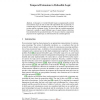1814 search results - page 44 / 363 » Extended First-Order Logic |
EPIA
1997
Springer
15 years 1 months ago
1997
Springer
Argumentation semantics in extended logic programming has been defined in [5,12] for a single agent which determines its believes by an internal argumentation process. In this pap...
AUSAI
2007
Springer
15 years 4 months ago
2007
Springer
In this paper, we extend Defeasible Logic (a computationally-oriented non-monotonic logic) in order to deal with temporalised rules. In particular, we extend the logic to cope with...
APIN
2002
14 years 9 months ago
2002
Abstract. In this paper, we describe how to realise alarm-correlation in cellular phone networks using extended logic programming which provides integrity constraints, implicit and...
SEMWEB
2007
Springer
15 years 3 months ago
2007
Springer
Classical ontologies are not suitable to represent imprecise nor uncertain pieces of information. As a solution we will combine fuzzy Description Logics with a possibilistic layer....
CONSTRAINTS
2007
14 years 9 months ago
2007
In the ECAD area, the Test Generation (TG) problem consists in finding an input vector test for some possible diagnosis (a set of faults) of a digital circuit. Such tests may have ...

